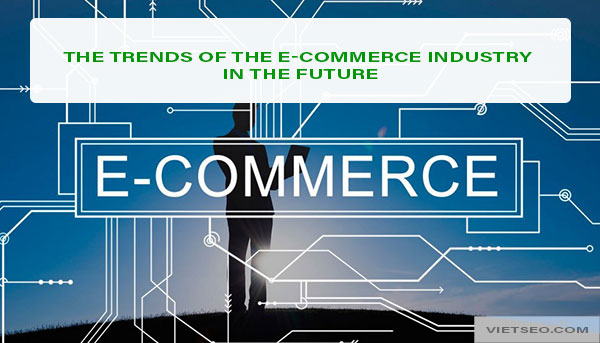The trends of the e-commerce industry in the future
In this article, let's take a look at the trends of the e-commerce industry in recent years so that businesses can better understand where to focus their efforts. force in 2023. Especially as experts have seen an increase in mobile sales and a shift towards social media – it will significantly affect the future of brands brand.
The global e-commerce market is growing at a rapid pace. It is expected that by the period of 2023 – 2025, this field is expected to reach a revenue of about 4.5 trillion USD and artificial intelligence (AI) technology, e-wallets… could be the emerging trends that will do the job. change the future of e-commerce.
As the pandemic broke out across the globe in 2023, E-Commerce became the open road for the retail industry. But while businesses are rapidly transforming their operations on online platforms, many are still not clear on which e-commerce channel to prioritize.
Future trends of e-commerce industry Trends of future e-commerce industry.
1. Multi-channel shopping
Today, the majority of consumers research brands online before they even set foot in a physical store. Because the customer journey now has a multitude of touchpoints across different devices, it is important for businesses to fully integrate their channels to provide an easy, comprehensive shopping experience.
Omnichannel procurement – seamless integration of a company's online and physical channels, which can be a valuable revenue driver. In fact, according to Google research, an omnichannel strategy can help generate an estimated 80% of a business' store visits.
2. AI and AR
While retailing on e-commerce sites prevails because of the convenience of consumers, the advantage of brick-and-mortar stores lies in the ability to “see with your own eyes – touch the product with your own hands”. Buyers can see and feel the actual products before deciding to spend money, giving them more confidence in their choices.
Artificial Intelligence (AI) and Augmented Reality (AR) are changing the online shopping experience, with things like: AI-powered Chatbots; Virtual assistant; AI-powered personalized shopping; AR apps help to recreate the real world online.
Ideally, these apps provide an easier, more enjoyable shopping experience for consumers. The AI and AR technologies themselves, when combined, leverage each other's strengths to deliver an enhanced shopping experience.
For example, an AI and AR-powered app could use voice recognition to listen to what you're saying, then display an image right in front of your eyes.
3. New payment option
Technological innovation aims to make the online shopping experience as seamless as possible. And checkout is an important part of that process, which is why businesses must offer customers multiple payment options at checkout, to reduce cart abandonment.
Some of the payment options include: E-wallets; Mobile payments; Electronic money. Where cryptocurrencies are especially relevant as companies become more and more open to blockchain technology and cryptocurrencies as payments.
4. The Rise of Visual Commerce
We live in an information overloaded world, which means brands are constantly competing for consumers' attention. That's why visual communication is more important than ever. Businesses are using visual tactics like high-quality photography, video, and AR to engage customers.
Just like an omnichannel strategy, visual commerce can dramatically increase revenue. According to Shopify research, customers who have viewed a product in AR are 65% more likely to make a purchase.
5. Data Driven, Dynamic Pricing
Dynamic pricing is when a business adjusts prices to reflect consumer demand. While this is not a new 'phenomenon', AI and new technology have made it more precise and accessible.
Companies like Amazon have implemented technology that helps the company optimize its pricing strategy, and other businesses that follow could see an increase in earnings.
So through the above content, it has partly helped you answer questions when you still do not understand the trend of the e-commerce industry in the context of current globalization.
Rise of e-commerce startups
1. Profit plays a more important role
In the past years, despite continuously receiving huge investments and breaking many records in terms of number of users, e-commerce floors in Vietnam have never achieved positive profits. In 2018, the total loss of 4 companies Lazada Vietnam, Tiki, Shopee Vietnam and Sendo amounted to VND 5,000 billion.
In the context of the need to educate consumers about online purchases, it is understandable that e-commerce companies have suffered losses for many years. However, the market in 2019 has seen major changes that are likely to affect the “burning money” strategy.
This is partly due to the fact that the unicorn startup WeWork suffered a heavy loss last year and did not show any prospects for profitability. The event made investors more cautious to avoid a second WeWork.
That trend is immediately affecting Asian tech startups. In India, two companies that were previously growing fast, ride-hailing startup Ola and booking startup OYO, cut thousands of employees to reduce losses.
In Indonesia, the Bukalapak e-commerce platform also recently laid off 250 employees. Explaining this decision, Mr. Teddy Oetomo, the company's Chief Strategy Officer, said that they want to target sustainable development instead of just short-term growth as before.
In Vietnam, the consecutive closures of Adayroi and Lotte due to the management company's change in business orientation are the first indicators of the trend to focus more on profitable business activities.
Going into 2023, the top e-commerce companies in Vietnam still have plenty of money to "burn". However, facing the general trend, iPrice Group predicts that these companies will gradually switch to pursuing specific profit goals instead of just racing for the number of users as before.
2. Fast delivery continues to be required
According to a study jointly conducted by iPrice Group and Parcel Perform in 2018, up to 34.1% of online shoppers in Southeast Asia are not satisfied with e-commerce delivery services. Also according to the study, Vietnam ranks second in the region in terms of average delivery time.
Realizing this is a weakness affecting the consumer experience in Vietnam, in 2019, e-commerce companies have launched commitments on fast delivery.
For example, Tiki commits to fast two-hour delivery with Tiki Now. To achieve this goal, in 2019, Tiki aggressively expanded its investment in infrastructure to develop its operation and warehousing system across the country.
Following Tiki, major competitors also introduced similar services in turn. Shopee Vietnam launched a fast delivery program in 4 hours and Sendo also committed to deliver in 3 hours in Ho Chi Minh City.
Entering 2023, fast delivery will still be one of the top consumer requirements for the e-commerce industry. According to Q&Me's Vietnam E-commerce Market Report 2019-2023, fast delivery is currently in the top 5 points to attract consumers to online shopping sites.
Thus, the focus on developing infrastructure and technology for fast delivery will certainly continue in 2023 and the outcome of the race will most likely be the deciding factor for the success or failure of companies. E-commerce in the coming years.
3. Opportunities for e-commerce companies in the bottom group
2019 saw the departure of a number of large e-commerce units such as Adayroi, Lotte and Robins, but it was also accompanied by the rise of startups that were not too big but really dynamic and effective.
The notable name among these is Lozi, an e-commerce portal that announced it had received an investment of up to tens of millions of dollars in October. Lozi's bright spot is that they own a separate transportation system under the LoShip brand, give it an edge in the fast-delivery race.
Besides Lozi are other names such as Telio, an e-commerce site aimed at sellers, or Leflair, an e-commerce site with the strength of branded products. In 2019, the two companies also received multi-million dollar investments to serve their expansion goals.
One factor that facilitates the success of startups is the growing demand for online shopping by Vietnamese people. According to iPrice Group's Q3 2019 E-commerce Map Report, the number of visits to Vietnam's e-commerce websites is now twice as high as that of Thailand and four times that of Malaysia.
When the demand for online shopping increases, consumers will also have more specific requirements for the quality of services and types of goods. And this is a great opportunity for startups to be born to serve these needs such as Lozi, Telio, Leflair.
In 2023, iPrice forecasts that Vietnam's e-commerce industry will witness a stronger development of small and medium-sized e-commerce companies following this trend.







